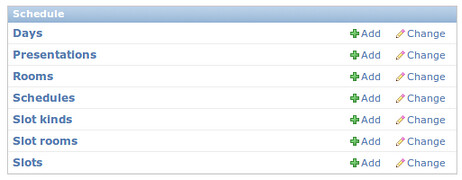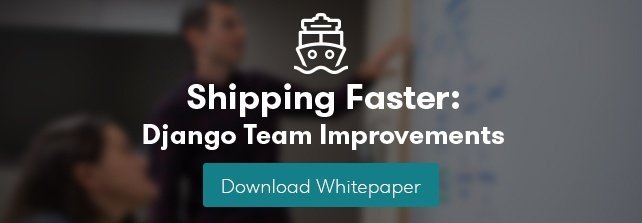
Recently Caktus collaborated with the organizers of PyOhio, a free regional Python conference, to launch the PyOhio 2014 conference website. The conference starts this weekend, July 26 - 27. As in prior years, the conference web site utilizes Eldarion’s Symposion, an opensource conference management system. Symposion powers a number of annual conference sites including PyCon and DjangoCon. In fact, as of this writing, there are 78 forks of Symposion, a nod to its widespread use for events both large and small. This collaboration afforded us the opportunity to abide by one our core tenets, that of giving back to the community.
PyOhio organizers had identified a few pain points during last year’s rollout that were resolvable in a manner that was conducive to contributing back to Symposion so that future adopters could benefit from this work. The areas we focused on were migration support, refining the user experience for proposal submitters and sponsor applicants, and schedule building.
Migration Support
https://github.com/pinax/symposion/pull/47
The majority of our projects utilize South for tracking database migrations. They are not an absolute requirement but for those conferences that reused the same code base from year to year, rather than starting a new repository, it would be beneficial to have a migration strategy in place. There were a few minor implementation details to tackle, namely migration dependencies and introspection rules. The Symposion framework has a number of interdependent apps. As such, when using migrations, the database tables must be created in a certain order. For Symposion, there are two such dependencies: Proposals depend on Speakers, and Sponsorship depends on Conferences. The implementation can be seen in this changeset. In addition, Symposion uses a custom field for certain models; django-timezones’ TimeZoneField. There are a few Pull Requests open on this project to deal with South and introspection rules, but none of them have been incorporated. As such, we add a very simple rule to work around migration errors.
As mentioned before, these migrations give Symposion a solid migration workflow for future database changes, as well as prepping for Django 1.7’s native schema migration support.
User Experience Issues
Currently, if an unauthenticated user manages to make a proposal submission, they are simply redirected to the home page of the site. Similarly, if an authenticated user without a Speaker profile makes a submission, they are redirected to their dashboard. In both cases, there is no additional feedback for what the user should do next. We utilized the django messages framework to provide contextual feedback with help text and hyperlinks should these be valid submission attempts (https://github.com/pinax/symposion/pull/50/files).
Sponsor submissions is another area that benefited from additional contextual messages. There are a variety of sponsor levels (Unobtanium, Aluminum, etc..) that carry their own sponsor benefits (print ad in program, for example). The current workflow redirects a sponsor application to the Sponsor Details page, with no contextual message, that lists Sponsor and Benefits details. For sponsor levels with no benefits, this essentially redirects you to an update form for the details you just submitted. Our pull request redirects these cases to the user dashboard with an appropriate message, as well as providing a more helpful message for sponsor applications that do carry benefits. (https://github.com/pinax/symposion/pull/49/files).
Schedule Builder
https://github.com/pinax/symposion/pull/51/files
The conference schedule is a key component to the web site, as it lets attendees (and speakers) know when to be where! It is also a fairly complex app, with a number of interwoven database tables. The screenshot below lists the components required to build a conference schedule:

At a minimum, to create one scheduled presentation requires 7 objects spread across 7 different tables. Scale this out to tens or nearly one hundred talks and the process of manually building a schedule become egregiously cumbersome. For PyCon 2014 we built a custom importer for the talks schedule. A quick glance reveals this is not easily reusable; there are pinned lunches and breaks, and this particular command assigns accepted proposals to schedule slots. For PyOhio, we wanted to provide something that was more generic and reusable. Rather than building out the entire schedule of approved talks, we wanted a fairly quick and intuitive way for an administrator to build the schedule’s skeleton via the frontend using a CSV file. The format of the CSV is intentionally basic, for example:
"date","time_start","time_end","kind"," room "
"12/12/2013","10:00 AM","11:00 AM","plenary","Room2"
"12/12/2013","10:00 AM","11:00 AM","plenary","Room1"
"12/12/2013","11:00 AM","12:00 PM","talk","Room1"
"12/12/2013","11:00 AM","12:00 PM","talk","Room2"
"12/12/2013","12:00 PM","12:45 PM","plenary","Room1"
"12/12/2013","12:00 PM","12:45 PM","plenary","Room2"
"12/13/2013","10:00 AM","11:00 AM","plenary","Room2"
"12/13/2013","10:00 AM","11:00 AM","plenary","Room1"
"12/13/2013","11:00 AM","12:00 PM","talk","Room1"
"12/13/2013","11:00 AM","12:00 PM","talk","Room2"
"12/13/2013","12:00 PM","12:45 PM","plenary","Room1"
"12/13/2013","12:00 PM","12:45 PM","plenary","Room2"
This sample, when uploaded, will create the requisite backend objects (2 Day, 2 Room, 2 Slot Kinds, 8 slots, and 12 SlotRoom objects). This initial implementation will fail if schedule overlaps occur, allows for front end deletion of Schedules, is tested, and provides documentation as well. Having a schedule builder will allow the conference organizers a chance to divert more energy into reviewing and securing great talks and keynotes, rather than dealing with the minutiae of administering the schedule itself.
Symposion is a great Python based conference management system. We are excited about its broad use in general, and in helping contribute to its future longevity and feature set.
Edited to Add (7/21/2014: 3:31PM): PR Merge Efforts
One of the SciPy2014 tech chairs, Sheila, is part of new efforts to get PRs merged. Join the mailing list to learn more about merges based off the PyOhio fork.


